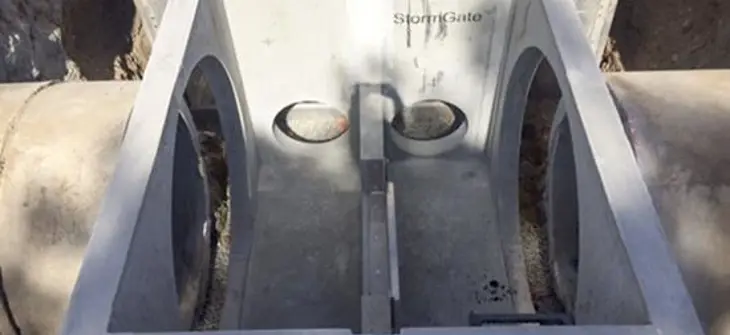
Don’t Bypass Good Design Part 2: Diverting the Flow
In a previous post (Don’t Bypass Good Design Part 1: Offline Vs. Online Diversion Structures), I wrote about bypass structures and argued that they deserved more attention. In this follow-up, we’ll do just that by comparing two different ways to divert flow in a precast manhole.
Option One: Using a manhole with different elevation outlet pipes
With this option, a smaller diameter outlet pipe near the bottom of the structure directs low flows to a water treatment or storage facility.
This pipe can be modeled as an orifice (if sufficiently short) or as a culvert to calculate the head required to drive the design flow through it. Once the head requirement is known, the invert of a larger high flow outlet pipe is placed at that elevation. This solution may work well as a retrofit, is inexpensive, and offers maximum flexibility of inlet to outlet pipe angle.

However, this options might not function as intended. For example, if the small pipe is in line with the larger pipe, high-velocity inflow will increase the discharge through the small pipe and hydraulic control will be lost. Additionally, since both pipes act as orifices, during high flow events too much flow could be directed through the low flow outlet (much more on this below). Finally, what is actually constructed in the field is not always what the engineer designed. The two outlet pipe design is particularly susceptible since it relies on the pipes being placed properly. In fact, because precast manhole openings are larger than the pipes’ outer diameters and wall thicknesses vary, minor construction variations and material selection could result in improper final results.
Option Two: Using a manhole with a weir
An arguably better method of designing high flow bypass uses a weir as shown in the diagram on the right. As in the prior example, a head is computed for the design flow. However, this time an overflow weir crest is set to this elevation, and excess water is allowed to spill over the weir into an outlet pipe.

The following example illustrates how these two designs compare using typical values from a small urban drainage basin. Assume a water quality flow rate of 1.0cfs and a design peak flow rate of 10 cfs. An 18” conveyance pipe would be suitable at 1% slope, so a designer may use a 48” manhole to provide bypass functionality. Assuming a 6” low flow pipe is selected, an estimated 1.3 feet of head would be required to reach the treatment rate. I’ve shown the stage-discharge for the 18” high flow pipe, and again with a 4ft long weir.

Graph of calculated discharge through different flow control devices.
In this example, the weir is able to bypass the peak flow at a calculated elevation of 2.25ft as indicated by the dashed red line to the left. At this stage, the treatment system would receive an estimated 1.33cfs, or 33% beyond the design rate. On the other hand, the high flow pipe design would require an elevation of 3.43ft to bypass the peak flow, as indicated by the dashed red line to the right. At that stage, the treatment system would receive 1.68cfs, or 68% above design. That is double the exceedance caused by the weir. So, why is this happening?
Note the flat characteristic of the orifice versus the exponential characteristic of the weir. The orifice discharge is proportional to h1/2 while the weir discharge is proportional to h3/2, as shown in the following equations:

The combination of weir and orifice is critical to being able to restrict flow to the treatment device while simultaneously maximizing the discharge over the weir. However, using two orifices (pipes, in this case) together does not provide the same benefit.
Weirs have other advantages over pipes for controlling flows. On a flat site with shallow pipes, the weir will perform better with limited freeboard. Similarly, some areas experience high-intensity storms, like the Gulf Coast that I supported as a design engineer for years. In those places, a weir will scale better than pipe by simple increasing the manhole diameter to utilize a longer weir. Which reminds me of one trick I’ve seen from the clever engineers of Texas: a box culvert placed vertically inside a vault takes advantage of the length of its four sides to maximize discharge.
